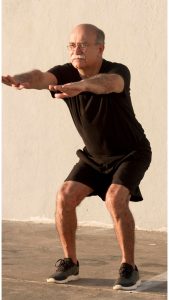Should Seniors Always Start Squats Without Weight?

The Initial Stages: Bodyweight Squats
For seniors new to squats or with limited mobility, initiating with bodyweight squats is often advisable. This allows them to master the movement pattern without added resistance, reducing the risk of injury. Bodyweight squats aid in building strength in the lower body, improving balance, and enhancing flexibility essential elements for overall well-being.
Gradual Progression: Introducing Weights
Once comfortable with bodyweight squats and as strength improves, seniors can gradually introduce weights. This progression should be cautious and supervised by a fitness professional to ensure proper form and prevent strain. Light dumbbells, resistance bands, or using a stable object for support can gradually increase resistance and challenge the muscles.

Importance of Form and Safety
Regardless of weight, emphasizing proper form is crucial. Seniors should focus on maintaining a straight back, engaging core muscles, and ensuring knees align with toes during the squat motion. Consulting a fitness expert or physical therapist can help customize the exercise to suit individual needs, ensuring safety and effectiveness.
Benefits Beyond Strength
Squats, when performed correctly and gradually advanced, offer a multitude of benefits for seniors. They promote mobility, strengthen muscles crucial for daily activities, and contribute to better posture and balance essential factors in preventing falls and maintaining independence as one ages.
So.
In summary, while starting with bodyweight squats is often recommended for senior beginners, the progression to incorporating weights can be beneficial under proper guidance. Prioritizing form, safety, and gradual progression is key to reaping the rewards of this functional exercise.
Remember, it’s crucial to personalize exercise routines based on individual abilities and health conditions. Always consult a healthcare professional before starting any new exercise program.
Understanding the Importance of Squats for Senior Beginners
Addressing Concerns: Safety First
For seniors, the hesitation to engage in squats often stems from concerns about joint strain or potential injury. However, when executed correctly, squats can actually benefit joint health. The controlled, gradual movement engages the muscles around the knees and hips, potentially reducing the risk of joint issues.
Adapting to Individual Needs
Seniors, particularly beginners, should tailor their approach to squats based on their specific abilities and health conditions. Some may require modifications due to arthritis, balance issues, or prior injuries. Consulting a physical therapist or certified trainer can aid in customizing squat variations that suit individual needs.
Functional Fitness: Beyond Strength
Squats are a functional exercise, meaning they replicate movements used in daily life, such as sitting and standing. For seniors, mastering proper squat technique can improve functional mobility, making everyday activities more manageable and reducing the risk of injury during routine tasks.
Enhancing Overall Well-being
The benefits of squats extend beyond physical strength. Engaging in regular exercise, like squats, can positively impact mental health by releasing endorphins, reducing stress, and boosting mood. For seniors, this holistic approach to fitness contributes to an overall sense of well-being.
Introducing Variety: Different Types of Squats
As seniors become comfortable with bodyweight squats, exploring variations can add diversity to their routine. Chair squats, wall squats, or using stability balls can offer alternatives that accommodate individual needs and abilities while still reaping the benefits of this exercise.
Conclusion
Seniors embarking on a fitness journey, especially with squats, should prioritize safety, personalized modifications, and gradual progression. The benefits of incorporating squats into a routine, from improving strength and balance to enhancing overall well-being, make them a valuable addition to a senior’s exercise regimen.
External Resources:
Explore these resources for a deeper understanding of adapting exercises for seniors and exploring squat variations:
American Council on Exercise – Safe and Effective Squat Technique
AARP – 7 Squat Variations for Older Adults
SilverSneakers – Squats: A Step-by-Step Guide
Mayo Clinic – Exercise and aging: Can you walk away from Father Time?
National Institute on Aging – Exercise & Physical Activity for Older Adults
Harvard Health – Balance exercises
Remember, every fitness journey is unique, and seeking guidance from professionals ensures a safe and effective experience. Always consult with a healthcare provider before starting any new exercise regimen, especially for seniors or individuals with specific health concerns.
Comparison tabular on this
| Aspect | Bodyweight Squats | Weighted Squats |
|---|---|---|
| Initial Resistance | Uses body weight only | Incorporates additional weight (dumbbells, bands, etc.) |
| Starting Difficulty | Generally easier for beginners | May pose more challenge initially |
| Risk of Injury | Lower risk due to lighter resistance | Potential risk if not executed with proper form |
| Muscle Engagement | Builds foundational strength | Increases resistance, enhancing muscle development |
| Progression | Gradual advancement to more reps/variations | Incremental addition of weight for progressive challenge |
| Functional Benefits | Improves mobility and balance | Strengthens muscles for daily functional movements |
| Customization | Easily modifiable for individual capabilities | Requires careful supervision for proper customization |
| Equipment Needed | None | May need weights or resistance bands for added load |
| Professional Guidance | Relatively straightforward | May require expert supervision for safe execution |
This table encapsulates the primary differences between bodyweight squats and weighted squats for senior beginners, emphasizing various factors crucial in choosing the appropriate type of squat for individual fitness levels and goals.
Wrapping up
In the journey toward fitness, especially for seniors taking the courageous step into exercise, squats stand as a gateway to strength, mobility, and overall well-being. Whether starting with bodyweight squats or gradually introducing weighted variations, the key lies in a personalized approach.
Embrace the journey, focusing on form, safety, and gradual progression. Seek guidance from professionals, tailor exercises to individual needs, and revel in the transformative power of squats. These simple yet impactful movements pave the way for improved functionality, confidence, and a healthier, more fulfilling lifestyle.
Remember, it’s never too late to start, and every step toward a healthier you is a victory worth celebrating. Stay committed, stay safe, and enjoy the journey toward a stronger, more vibrant you.

Hey there, it’s Mike Rrsq, the Editor-in-Chief over at Jsquat.com, and I’m absolutely obsessed with all things squat fitness! I’ve been lucky enough to get some serious recognition for my work in this field. With a solid background in the fitness and wellness industry, I’ve been there right from the get-go, helping shape this website into what it is today.
You see, I’m not just the boss around here; I’m also a passionate contributor. I love sharing my insights through my articles, and trust me, they’re not your run-of-the-mill stuff. Each piece I write is a labor of love, filled with my expertise and real-world experience in the fitness universe. So, if you’re into fitness and looking for some inspiration, you’re in the right place!
Related Posts
- Should beginners perform prisoner squats with or without shoes
The choice between doing prisoner squats with or without shoes, especially for beginners, can impact…
- Are Squats Without Weight Effective? (Explained)
Are you wondering if squats without weight are worth your time? Learn the benefits and…
- Should beginners incorporate squats to correct muscle imbalances
Muscle imbalances can affect anyone, from beginners to seasoned athletes. Addressing these imbalances is crucial…
- How to put mass on your legs without barbell squats
Building mass in your legs without relying on barbell squats is definitely possible. While squats…
- Are squats more suitable when using a Smith machine or free weights
Squats, the cornerstone of lower body workouts, ignite debates among fitness enthusiasts: Smith machine or…
- Should Asian Squats Be Done by Female Beginners for Toning Thighs
Toning thighs is a fitness goal many women pursue, and Asian squats often surface as…
- Is it recommended for beginners to perform squats six times a month for hamstring development
Absolutely. squats are fantastic exercises for beginners looking to strengthen their hamstrings along with other…
- Why you sometimes become dizzy when doing back squats with 100kg weights
When diving into the world of weightlifting, particularly with exercises like back squats, encountering moments…
